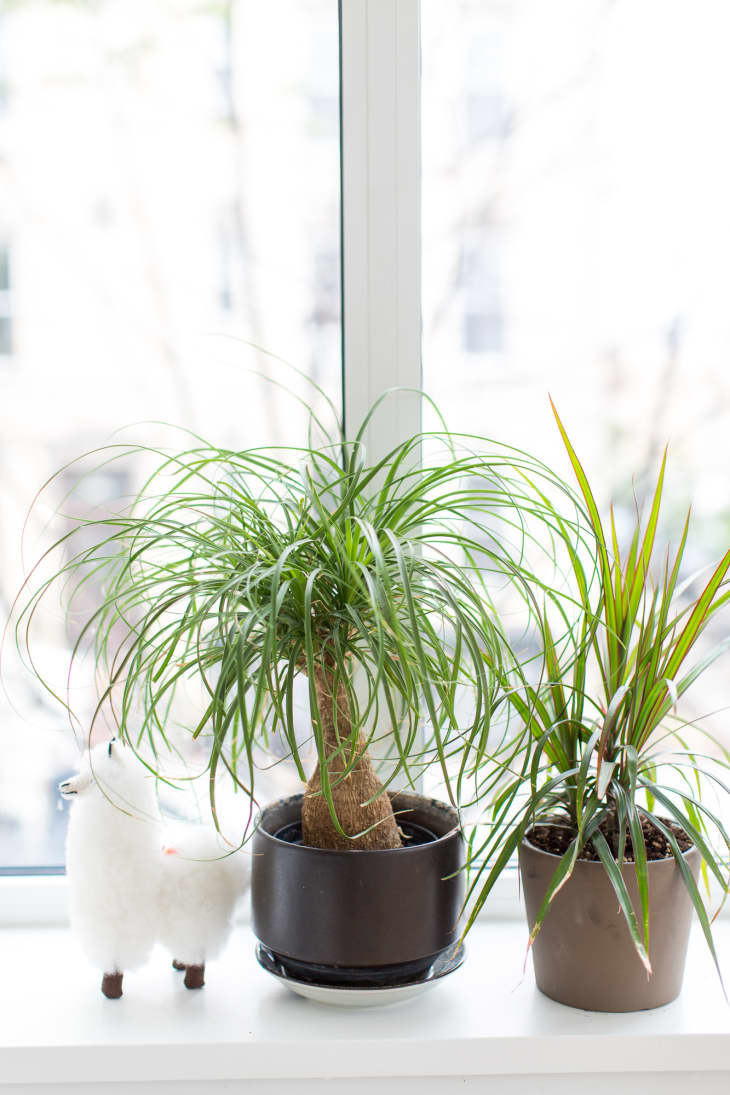
With its bulbous trunk, cascading ponytail of leaves, and endearing proportions, the ponytail palm is a cute plant that happens to be pretty low maintenance. A slow-grower that can reportedly live for decades, or even centuries, it’s no wonder that the ponytail palm is a popular houseplant choice. If you’re convinced that you need one of your own, here’s how to keep one happy.
About This Plant
Don’t let the name mislead you: ponytail palms aren’t actually palms at all, and are more closely related to lilies, but need the kind of care you’d give a cactus or succulent. Maybe it’s less confusing to stick with the scientific name of this native of southeastern Mexico, Beaucarnea recurvata, or one of the other common names, elephant-foot plant or bottle plant.
While ponytail palms can reach heights of 20 feet or more in the outdoors, they are also often grown as bonsai specimen. They may produce flower stalks in the summer when grown outdoors. Under normal conditions indoors, though, they probably won’t flower, or reach more than about 3 feet tall.
The ASPCA says that the ponytail palm is non-toxic to dogs and cats (and horses, if you happen to be keeping one of those in your house).

Where to Grow
Ponytail palms prefer full sun or bright, indirect light, with ideal temperatures above 45° F (7° C) at night. Although full sun is best, this forgiving plant can tolerate lower light, and will just grow more slowly. As desert-natives, ponytail palms don’t need much humidity, but placement near a draft or vent should be avoided as it may dry out the foliage.
Your indoor ponytail palm may enjoy a sunny summer vacation outside, but be sure to transition it slowly to the outdoors, and bring it back inside when the temperatures start to dip into the 40s at night.

Care and Planting
Care for this plant like you would a cactus or succulent, planting it in cactus or succulent soil in a container with drainage. Let the soil dry out well between waterings, generally every two weeks (but these can even go up to a month). When you do water, saturate the soil until water comes out of the bottom of the pot, and let it drain. Never let it sit in water (this applies to pretty much any houseplant). With its ability to store water in its bulbous trunk, you can usually err on the side of underwatering your ponytail palm, but dried out, brown leaves, and/or a shriveled trunk, will let you know that you’re not giving it enough water. Yellow foliage or a mushy trunk likely means you’re overwatering.
Most problems with this plant come from overwatering, but it can occasionally suffer from pests like spidermites, scale, or mealybugs, which are treated with a systemic insecticide.
You may be tempted to give this plant’s ponytail a haircut, but doing so will lead to browning on the edges of the leaves. Fertilize once a month with cactus fertilizer in the winter, and then, when new growth starts to appear in the spring, fertilize every one to two weeks throughout the spring and summer growing season.
How to Propagate
Ponytail palms can be propagated from seed, but a more practical way to propagate them is to wait for a plant to produce a “pup,” which you can eventually separate from the parent plant. Wait until it is developing roots, then cut it away from the parent with a clean knife, and put it in its own pot. Keep the soil moist to help the young plant get enough water while it further develops its own root system.
Hải Yến
Gió bạn với cây tự buổi nào ,
Gió về cây lại ngất ngư chao .
Gió đi cây sẽ im lìm đứng,
Như kẻ lỡ làng dạ khát khao .



